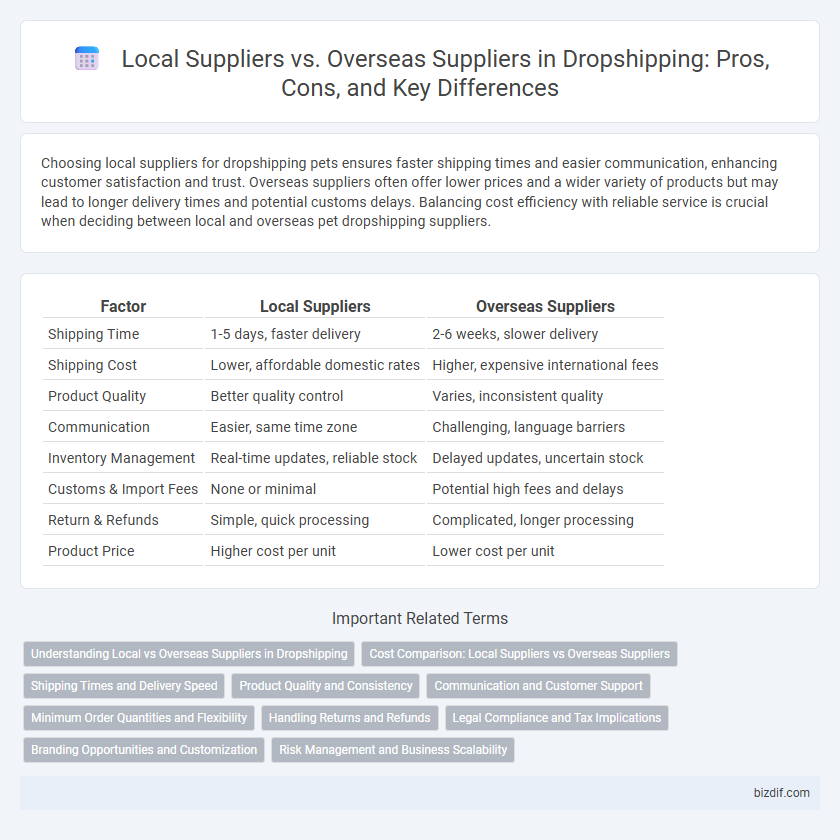Choosing local suppliers for dropshipping pets ensures faster shipping times and easier communication, enhancing customer satisfaction and trust. Overseas suppliers often offer lower prices and a wider variety of products but may lead to longer delivery times and potential customs delays. Balancing cost efficiency with reliable service is crucial when deciding between local and overseas pet dropshipping suppliers.
Table of Comparison
| Factor | Local Suppliers | Overseas Suppliers |
|---|---|---|
| Shipping Time | 1-5 days, faster delivery | 2-6 weeks, slower delivery |
| Shipping Cost | Lower, affordable domestic rates | Higher, expensive international fees |
| Product Quality | Better quality control | Varies, inconsistent quality |
| Communication | Easier, same time zone | Challenging, language barriers |
| Inventory Management | Real-time updates, reliable stock | Delayed updates, uncertain stock |
| Customs & Import Fees | None or minimal | Potential high fees and delays |
| Return & Refunds | Simple, quick processing | Complicated, longer processing |
| Product Price | Higher cost per unit | Lower cost per unit |
Understanding Local vs Overseas Suppliers in Dropshipping
Local suppliers in dropshipping offer faster shipping times and easier communication, enhancing customer satisfaction and reducing logistical challenges. Overseas suppliers typically provide lower product costs and a wider range of inventory but come with longer delivery times and potential customs delays. Evaluating factors such as shipping speed, product quality, and cost efficiency is crucial for optimizing dropshipping success.
Cost Comparison: Local Suppliers vs Overseas Suppliers
Local suppliers typically offer faster shipping times and reduced shipping costs, which can lower overall expenses despite higher product prices. Overseas suppliers often provide significantly lower product costs but incur longer shipping durations and additional fees such as customs duties and import taxes. Evaluating total landed cost, including product price, shipping, and tariffs, is essential to determine the most cost-effective dropshipping supplier option.
Shipping Times and Delivery Speed
Local suppliers significantly reduce shipping times, often delivering products within 2-5 business days, enhancing customer satisfaction and retention. Overseas suppliers typically require 2-6 weeks for delivery due to longer transit distances and customs processing, which can lead to increased shipping costs and potential delays. Faster delivery from local suppliers can improve order fulfillment rates and increase competitive advantage in the dropshipping market.
Product Quality and Consistency
Local suppliers often provide higher product quality and greater consistency due to shorter supply chains and stricter quality control standards. Overseas suppliers may offer lower costs but can present challenges with variability in materials and manufacturing processes, potentially leading to inconsistent product quality. Ensuring reliable product standards requires thorough vetting and continuous communication regardless of supplier location.
Communication and Customer Support
Local suppliers offer faster and clearer communication due to shared time zones and language, enhancing real-time problem resolution and customer support efficiency. Overseas suppliers may face delays and misunderstandings from language barriers and time differences, impacting response times and order accuracy. Effective communication with local suppliers often leads to improved customer satisfaction and smoother operational workflows in dropshipping.
Minimum Order Quantities and Flexibility
Local suppliers often offer lower minimum order quantities (MOQs), providing greater flexibility for dropshippers to test products and manage inventory without large upfront investments. Overseas suppliers typically require higher MOQs, which can reduce flexibility but may result in lower unit costs due to bulk production. Choosing between local and overseas suppliers involves balancing MOQ requirements with cost-efficiency and agility in responding to market demand.
Handling Returns and Refunds
Local suppliers offer faster handling of returns and refunds due to proximity, reducing shipping costs and delivery times. Overseas suppliers often result in longer return processes, increased shipping expenses, and potential customs delays. Efficient return policies from local suppliers enhance customer satisfaction and streamline inventory management in dropshipping operations.
Legal Compliance and Tax Implications
Choosing local suppliers in dropshipping often simplifies legal compliance due to familiarity with domestic trade regulations and tax policies, reducing risks of customs delays and unexpected tariffs. Overseas suppliers may offer lower costs but introduce complexities such as import duties, value-added tax (VAT) obligations, and stricter international commerce laws, requiring careful adherence to avoid penalties. Understanding jurisdiction-specific legal frameworks and tax reporting requirements ensures smoother operations and protects profit margins in cross-border dropshipping transactions.
Branding Opportunities and Customization
Local suppliers offer enhanced branding opportunities through faster turnaround times and easier communication, enabling tailored packaging and personalized products that strengthen brand identity. Overseas suppliers often provide cost-effective bulk customization options but may face challenges with longer lead times and quality control, potentially impacting consistent brand representation. Selecting the right supplier depends on balancing customization needs with reliable branding execution to maximize customer satisfaction and brand loyalty.
Risk Management and Business Scalability
Local suppliers offer reduced shipping times and lower risk of supply chain disruptions, enhancing reliable inventory management and customer satisfaction in dropshipping. Overseas suppliers often provide cost advantages and a wider product selection, but introduce risks such as longer shipping delays, customs challenges, and quality control issues that can impact scalability. Businesses prioritizing risk management should weigh the trade-offs between local supplier reliability and overseas supplier cost efficiency to optimize dropshipping growth strategies.
Local Suppliers vs Overseas Suppliers Infographic

 bizdif.com
bizdif.com